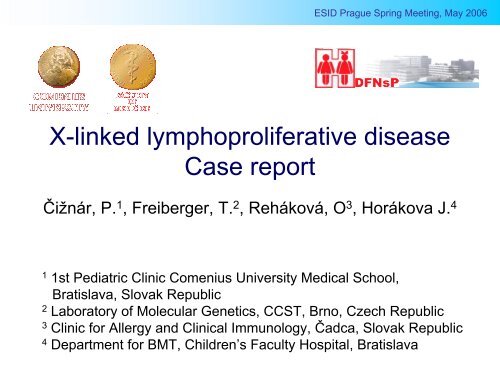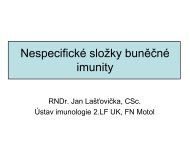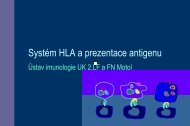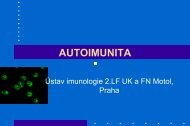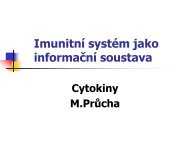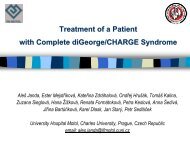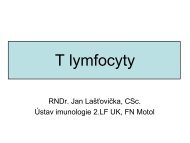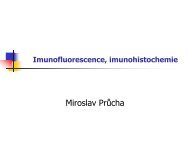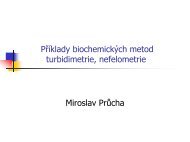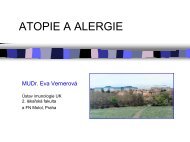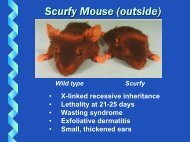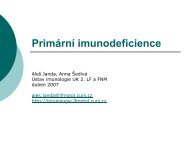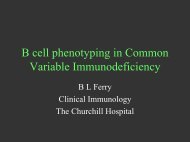X-linked lymphoproliferative disease Case report
X-linked lymphoproliferative disease Case report
X-linked lymphoproliferative disease Case report
Create successful ePaper yourself
Turn your PDF publications into a flip-book with our unique Google optimized e-Paper software.
ESID Prague Spring Meeting, May 2006<br />
X-<strong>linked</strong> <strong>lymphoproliferative</strong> <strong>disease</strong><br />
<strong>Case</strong> <strong>report</strong><br />
Čižnár, P. 1 , Freiberger, T. 2 , Reháková, O 3 , Horákova J. 4<br />
1 1st Pediatric Clinic Comenius University Medical School,<br />
Bratislava, Slovak Republic<br />
2 Laboratory of Molecular Genetics, CCST, Brno, Czech Republic<br />
3 Clinic for Allergy and Clinical Immunology, Čadca, Slovak Republic<br />
4 Department for BMT, Children’s Faculty Hospital, Bratislava
History of XLP<br />
ESID Prague Spring Meeting, May 2006<br />
• 1975 Purtilo DT et al. <strong>report</strong>ed first case of 6<br />
male relatives (Duncan kindred) died from<br />
progressive combined variable ID associated<br />
with aberrant proliferation of lymphocytes and<br />
macrophages. In three of these boys EBV<br />
primary infection confirmed.<br />
• 1989 Skare JC. Disease mapped to single<br />
gene locus Xq25.
Phenotype<br />
XLP clinical phenotype<br />
• Fulminant infectious<br />
mononucleosis (FIM)<br />
• Lymphoproliferative disorders<br />
• Dysgammaglobulinemia<br />
• Hemophagocytic syndrome<br />
• Autoimmunity (vasculitis,<br />
colitis, psoriasis, aplastic<br />
anemia)<br />
Affected<br />
(%)<br />
ESID Prague Spring Meeting, May 2006<br />
Median age at<br />
onset (years)<br />
Average<br />
survival<br />
60 5 1-3 m<br />
20-30 5 + / 8- EBV+/-<br />
30 7-9 EBV+/-<br />
+/- = EBV status<br />
1.) Seemayer TA et al. In Goedert JJ. Infectious Causes of Cancer. 2000.<br />
2.) Surnegi J et al. Blood 2000, 96, 3118-3125.<br />
3.) Schuster V, Kreth HW. In Ochs HD, PID a Molecular and Genetic Approach. 1999.
ESID Prague Spring Meeting, May 2006<br />
ESID diagnostic criteria for XLP<br />
• Definitive<br />
Male patient with lymphoma/ Hodgkins <strong>disease</strong>, fatal EBV infection,<br />
immunodeficiency, aplastic anemia or lymphohistiocytic disorder<br />
who has a mutation in SH2D1A/SAP/DSHP.<br />
• Probable<br />
Male patient experiencing death, lymphoma/Hodgkins <strong>disease</strong>,<br />
immunodeficiency, aplastic anemia or lymphohistiocytic disorder<br />
following acute EBV infection and maternal cousins, uncles or<br />
nephews with a history of similar diagnoses following acute EBV<br />
infection.<br />
• Possible<br />
Male patient experiencing death, lymphoma/Hodgkin's <strong>disease</strong>,<br />
immunodeficiency, aplastic anemia or lymphohistiocytic disorder<br />
following acute EBV infection.
Gene SH2D1A<br />
Locus Xp25<br />
Protein SH2<br />
ESID Prague Spring Meeting, May 2006<br />
Expression T, NK, NKT cells<br />
Function<br />
Binding to SLAM<br />
receptors
Model of signaling lymphocytic activation<br />
molecule (SLAM) – associated protein (SAP)<br />
function in T and NK cells<br />
SAP mediate recruitment and<br />
activation of the Fyn tyrosine kinase<br />
which leads to phosphorylation of<br />
the SLAM and 2B4 cytoplasmic tails<br />
SAP and Fyn recruit PKC-0 and Bcl-10<br />
and activate specific NF-κB family<br />
members following TCR ligation<br />
Kim E. Nichols, K.E. a spol., Immunol Rev 2005, Vol. 203: 180–199.
ESID Prague Spring Meeting, May 2006<br />
Sap–/– mice and human XLP patients<br />
demonstrate defects in NKT cells<br />
Kim E. Nichols, K.E. a spol., Immunol Rev 2005, Vol. 203: 180–199.
ESID Prague Spring Meeting, May 2006<br />
Different classes of SAP gene alterations<br />
• Macro / microdeletions resulting in complete or<br />
partial deletion of the SAP gene<br />
• Mutation interfering with mRNA transcription or<br />
splicing<br />
• Nonsense mutations leading to premature<br />
termination of the polypeptide synthesis<br />
• Missense mutations resulting in amino acids<br />
substitutions<br />
Genotype / phenotype correlation not proved yet
<strong>Case</strong> <strong>report</strong><br />
ESID Prague Spring Meeting, May 2006<br />
Currently healthy 15-year-old boy referred to<br />
Pediatric University Hospital in Bratislava from<br />
regional Allergy - Immunology Clinic
History<br />
ESID Prague Spring Meeting, May 2006<br />
• Pregnancy normal until 8 th month, then mother<br />
hospitalized for late gestosis and gestational diabetes.<br />
Delivery per S.C. for pelvic position. Birth weight 4400g,<br />
birth length 54cm. Postnatal transitory apnea attacks with<br />
hypoglycemia, bradycardia, shortly resuscitated.<br />
Vaccination postponed until 2 nd year, then all<br />
recommended + Hepatitis B and Influenza. Breast fed 7<br />
months, General morbidity low.<br />
• Repeated immunology workup with inconsistent findings: T<br />
cells ↓ -N;IgG, IgA↓ -N.<br />
• At the age of 10 admitted to regional hospital with acute<br />
perforation of ileum. Histology confirmed lymphoma (Non-<br />
Hodgin diffuse with large-cells, B-type II. clinical stage<br />
according to Murphy classification). Oncologic treatment<br />
after 6 month considered successful.
I.<br />
Pedigree<br />
ESID Prague Spring Meeting, May 2006<br />
II. ?<br />
* 1985<br />
† 1986<br />
14 mo<br />
encephalitis<br />
sepsis<br />
* 1986<br />
† 1987<br />
8 mo<br />
sepsis<br />
susp. leukemia<br />
susp. unspecified ID
Laboratory results I.<br />
Blood count<br />
• Hb 155 g/L<br />
• Tr 186 x 10 9<br />
• Leu 5,82 x 10 9<br />
• Ly 34,6% (2,02x10 9 )<br />
• Neu 55,4%(3,23x10 9 )<br />
• Eo 3,1 % (0,18x10 9 )<br />
• Mo 0,36% (0,36x10 9 )<br />
• Ba 0,7 % (0,04x10 9 )<br />
Phagocytosis normal<br />
ESID Prague Spring Meeting, May 2006<br />
Lymphocyte count<br />
• CD3+ 76,7 %<br />
• CD4+ 32,6 % ↓<br />
• CD8+ 33,7 %<br />
• CD4/CD8 0,97 ↓<br />
• CD16+ 6,1 % ↓<br />
• CD19+ 9,2 % ↓<br />
Decreased proliferative<br />
response to ConA.<br />
Response to PHA, aCD3<br />
and PWM normal.
Immunoglobulins<br />
• IgG 5,44.. 8,1 g/L<br />
• IgA 0,24.. 0,17 g/L<br />
• IgM 0,67.. 0,69 g/L<br />
• IgE 3,9.. 4,8 IU/ml<br />
Autoantibodies<br />
• ANA, ASMA, AMA,<br />
APCA, ATA, ARA<br />
negative<br />
• RF negative<br />
Laboratory results II.<br />
ESID Prague Spring Meeting, May 2006<br />
Antiinfective response<br />
a-chlamydia (IgG,IgM) negat.<br />
a-borelia (IgG, IgM) negative<br />
a-CMV IgG 1:2000<br />
IgM negative<br />
ASO 51,9<br />
a-EBV(IgG, IgM) negative<br />
EBV-DNA PCR negative<br />
EBV-DNA RT-PCR negative<br />
Biochemistry and inflammatory markers normal
CD8 T cells<br />
NK cells<br />
B cells<br />
SAP expression [%]<br />
ESID Prague Spring Meeting, May 2006<br />
Patient Mother Control<br />
( 1,1% ) ( 40,8% ) ( 89,7% )<br />
( 0,14% ) ( 47,6% ) ( 89,7% )<br />
( 0,99% ) ( 5,9% ) ( 0,81% )
• gene SH2D1A<br />
Genetic analysis<br />
• Type of mutation: EX2del<br />
ESID Prague Spring Meeting, May 2006<br />
• Character of mutation: deletion of large<br />
extent<br />
• exon: 2
Current treatment<br />
• Prophylactic IVIG 0,4g/kg monthly<br />
• Prophylactic aciclovir 3x200mg<br />
ESID Prague Spring Meeting, May 2006<br />
• HLA analysis of the patient, parents and sister<br />
– sister is haploidentical<br />
• 1st donor registry search<br />
A A B B C C<br />
Patient 1101 2402 3503/3513 4405 w0202 w0401<br />
Donor 1101 2402 3501 4402 w0501 w0401<br />
DRB1 DRB1 DQB1 DQB1<br />
Patient 0301 1601 0201 0502<br />
Donor 0301 1601 0201 0502
Conclusion<br />
ESID Prague Spring Meeting, May 2006<br />
• XLP has a heterogeneous clinical phenotype with variability in<br />
severity of presentation. A high index of suspicion and<br />
awareness is required that appropriate investigations can be<br />
carried out.<br />
• Genetic diagnosis can now be made (SAP gene mutations ), but<br />
a number of cases with highly suggestive clinical presentation<br />
have normal SAP gene sequences. SAP protein expression is<br />
therefore essential.<br />
• EBV infection is not necessary to trigger the clinical<br />
manifestations of XLP.<br />
What should be the right decision in our patient if the second search fail?<br />
- Wait for a third search<br />
- Haploidentical sibling marrow donor transplant<br />
- Unmatched donor transplant
Acknowledgements<br />
Camelia Botnar Laboratories, Great Ormond Street for<br />
Children NHS Trust<br />
• Kimberley C Gilmour<br />
ESID Prague Spring Meeting, May 2006<br />
Molecular Immunology Unit, Institute of Child Health, London<br />
• H Bobby Gaspar<br />
Masaryk University Medical School, Institute for Clinical<br />
Immunology and allergy, Brno<br />
• Prof J Litzman<br />
• V Thon


